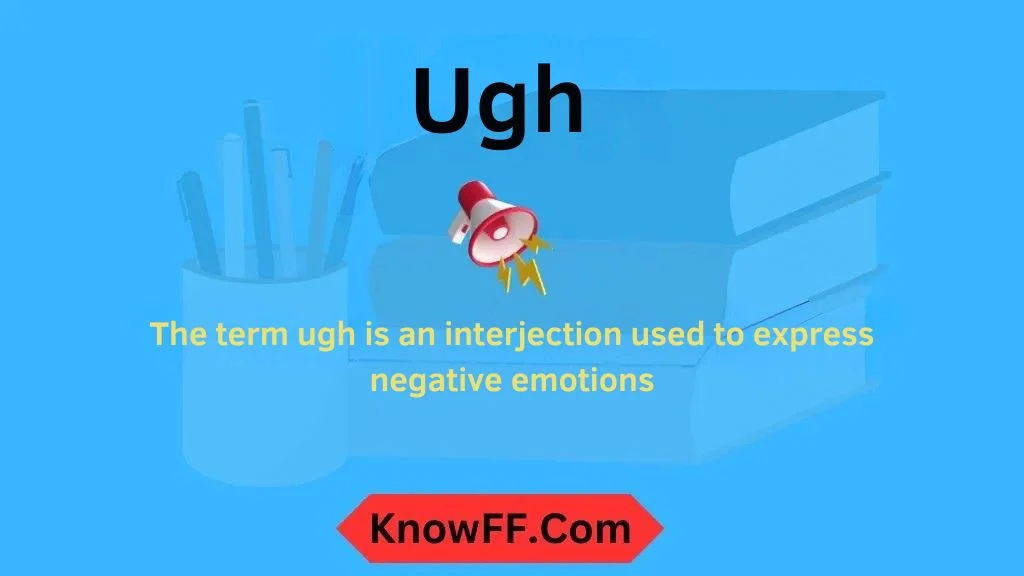In the digital age, expressions and abbreviations have become an essential part of communication.
One such term is “ugh”, frequently seen in texts, social media posts, and messaging apps.
People often search for “ugh meaning in text” to understand its emotional tone, context, and correct usage.
Unlike formal words, ugh conveys emotion rather than precise information. Its popularity stems from its ability to express frustration, disappointment, annoyance, or fatigue in a single, concise expression.
Knowing the meaning of ugh helps users interpret online messages accurately, ensuring better understanding in casual conversations, professional chats, and social media interactions.
Whether you encounter ugh on WhatsApp, Instagram, or TikTok, understanding its nuances can prevent misunderstandings and make online communication more relatable and expressive.
Meaning & Definition
The term ugh is an interjection used to express negative emotions, often linked to discomfort, annoyance, or frustration. Unlike formal language, ugh relies on tone, context, and accompanying text to convey its meaning.
While the word itself does not have a complex definition, it functions as a verbal shorthand for feelings that might otherwise require longer explanations. In essence, ugh communicates exasperation, distaste, or displeasure in an informal, relatable way.
The meaning can shift slightly depending on the context, making it versatile for casual online chats and social media posts.
Background
The word ugh has been used in English for decades as a vocal expression of disgust or frustration. Historically, it appeared in literature and theater to mimic human reactions to unpleasant experiences.
With the rise of texting and social media, ugh evolved into a widely recognized internet shorthand, allowing users to convey complex emotions efficiently. Its simplicity and relatability contribute to its popularity, making it a staple in online communication.
Understanding the origin and evolution of ugh provides insight into how informal expressions shape digital interactions today.
Usage in Different Contexts
Ugh is highly context-dependent. In casual conversations, it might reflect annoyance with minor inconveniences. In social media, it can express dissatisfaction with trends, posts, or situations.
Interestingly, in professional settings, overusing ugh may be considered unprofessional or too informal. Context determines whether it conveys humor, sarcasm, genuine frustration, or exaggeration. The flexibility of ugh allows it to communicate emotions quickly, making it a favored expression in various digital platforms.
Meaning in Chat, WhatsApp, Instagram, TikTok
On messaging apps like WhatsApp, ugh often signals impatience, frustration, or disappointment with a situation or message. On Instagram or TikTok, it can reflect reactions to posts, stories, or trends that the user finds irritating, disappointing, or cringe-worthy.
Paired with emojis, gifs, or hashtags, ugh becomes a powerful emotional tool, enhancing the expression beyond words alone. It’s a simple, relatable way to convey reactions in online conversations.
Meaning in Physics, Medical, and Aircraft Terminology
Interestingly, outside casual conversation, UGH may appear as an acronym in specialized fields. In physics, it can refer to specific technical terms in rare instances (though not widely recognized).
In medical terminology, UGH can stand for “upper gastrointestinal hemorrhage”, indicating a serious condition involving bleeding in the upper digestive tract. In aviation, it might be used informally as shorthand in flight manuals or logs but is not standard. Awareness of context is critical to avoid confusion between casual usage and professional acronyms.
Common Misconceptions
Many people assume ugh is negative in every context, but it can also convey playful annoyance, mild exasperation, or dramatic emphasis for humor. Another misconception is equating it with swearing, but ugh is mild and socially acceptable.
Recognizing the subtle differences in tone is essential for accurate interpretation, especially in cross-cultural online conversations.
Similar Terms & Alternatives
Other expressions similar to ugh include meh, ughgh, argh, and yuck. Each has a slightly different nuance:
- Meh: boredom or indifference
- Argh: frustration or anger
- Yuck: disgust, usually physical
Choosing the right term depends on the emotion being expressed and the context of the conversation.
How to Respond to It
When someone texts ugh, an appropriate response depends on context:
- Empathetic: “I know, that’s frustrating!”
- Humorous: “Tell me about it 😅”
- Neutral: Simply acknowledge: “Got it”
Matching the tone shows attentiveness and ensures smooth communication.
Differences from Similar Words
Unlike argh (anger) or yuck (disgust), ugh has a broader emotional range. It can indicate minor frustration, boredom, or tiredness, making it more versatile. Recognizing these subtle distinctions helps avoid misinterpretation in text conversations.
Relevance in Online Conversations & Dating Apps
In online dating apps, ugh can reflect disappointment, mild frustration, or playful teasing. Its informal, relatable tone makes it suitable for casual conversation, helping users convey emotions without overexplaining.
On platforms like Instagram or TikTok, ugh is part of the cultural lexicon, allowing users to engage with trends and humor effectively. Its relevance continues to grow as digital communication evolves.
FAQs
What does ugh mean in texts?
It expresses frustration, annoyance, or mild disgust in informal communication.
Is ugh positive or negative?
Mostly negative, but can be playful or humorous depending on context.
Can ugh be used professionally?
Rarely; it is generally informal and better suited for casual conversations.
Are there alternatives to ugh?
Yes, alternatives include meh, argh, and yuck.
Does ugh have any medical meaning?
Yes, UGH can refer to upper gastrointestinal hemorrhage in medical contexts.
How should I respond to ugh in messages?
Empathize, joke, or acknowledge the sentiment depending on the tone.
Conclusion
The expression ugh is a concise, versatile way to convey emotions like frustration, annoyance, or mild exasperation.
Its popularity in texting, social media, and casual conversations stems from its simplicity and relatability.
While often informal, understanding its context, nuances, and similar terms ensures clear communication.
Additionally, recognizing its professional or medical acronyms helps avoid confusion.
Whether encountered on WhatsApp, Instagram, TikTok, or even in specialized terminology, ugh continues to be an essential part of modern digital expression.
Mastering its use can improve online interactions and make messaging more expressive and enjoyable.











